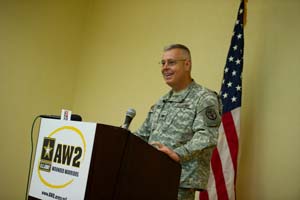By Alan Morales, WTC Stratcom

(left to right) WTC Commander BG Darryl A. Williams, AW2 Director COL Greg Gadson, and AW2 Sergeant Major SGM Robert Gallagher listen to participant questions at the 2011 AW2 Annual Training Conference.
Yesterday morning, I witnessed BG Darryl A. Williams give a keynote speech to a group of Army Wounded Warrior Program (AW2) Advocates and other guests in Dallas, TX. During this speech he motivated and energized staff to continue excelling in their efforts to better serve the Army’s wounded, ill, and injured. However, it was only a few moments after his speech that I witnessed BG Williams enter a much a smaller room, take the microphone off, and take a seat at a table with seven wounded warriors from the local Dallas area. This time around, BG Williams was the one doing the listening.
The luncheon took place on day two of the 2011 AW2 Advocate Annual Training–an event where 170+ Advocates nationwide have convened to train and collaborate to better provide individualized support to the Army’s severely wounded, ill, and injured. Making a stop to address the attendees, BG Williams made it a priority to also take the opportunity to meet local wounded warriors.
During the luncheon, BG Williams, along with AW2 Director COL Greg Gadson and AW2 Sergeant Major SGM Robert Gallagher, listened to wounded warriors explain various challenges, such as Social Security benefits claims, difficulties in continuing on active duty, and the difficulties involved with civilian integration. The discussion served as a mechanism for BG Williams to better understand both new and persistent issues that face the wounded warrior population.
After hours of taking notes and posing questions to his guests, BG Williams concluded the luncheon by sharing with the table a few words that resonated with the group. BG Williams said, “I regularly speak to officials at the Department of Defense, Department of the Army, Congress, and various others in Washington. I’m here to tell you that it’s not worth a can of beans unless I connect with the Soldier to understand how what I do in Washington affects him or her.”
Feedback isn’t limited to the walls of a conference room. It continues in the virtual world. Share with us your thoughts about the Army’s warrior care programs. Whether you are in a Warrior Transition Unit, Community-Based Warrior Transition Unit, or a Veteran, share with us your thoughts by posting a comment below.








